To master drone Follow-Me mode, start by selecting a GPS-enabled drone with robust autonomous flight capabilities and a high-quality camera. Optimize your settings with an altitude of 10-15 feet and a follow distance of 15-20 feet for smooth tracking. Adjust speed to match your subject and enable obstacle avoidance for safety. Experiment with advanced tracking patterns like orbit, reveal, and parallax to add dynamism to your shots. Combine Follow-Me with other flight modes for versatile footage. Don't forget to take into account legal requirements and respect privacy laws. These pro tips are just the beginning of your journey to cinematic aerial mastery.
Key Takeaways
- Choose a drone with robust autonomous flight capabilities and high-quality camera features for optimal Follow-Me performance.
- Set optimal distance (15-20 feet) and altitude (10-15 feet) for smooth tracking and balanced composition.
- Master various tracking patterns like orbit, reveal, and parallax to create dynamic and engaging footage.
- Plan routes, adjust for obstacles, and consider environmental factors to ensure safe and effective autonomous flight.
- Maximize battery life through proper charging, calibration, and intelligent power management during Follow-Me mode operations.
Understanding Follow-Me Mode Basics
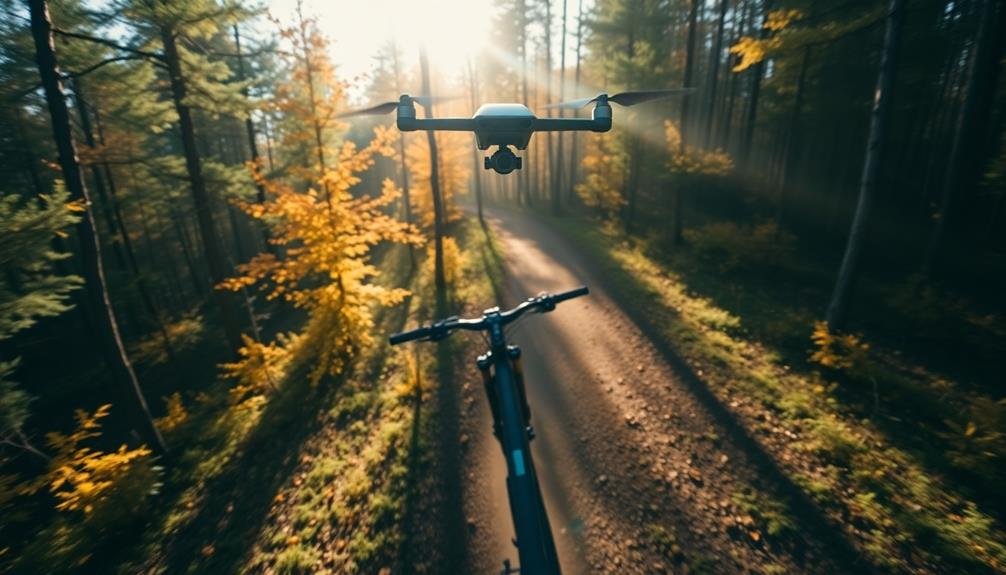
Over the past few years, drone technology has advanced rapidly, with Follow-Me mode emerging as a game-changing feature. This intelligent function allows your drone to autonomously track and film you as you move, creating dynamic footage without manual piloting.
To use Follow-Me mode effectively, you'll need a GPS-enabled drone with this capability. The drone typically relies on GPS signals from your smartphone or a dedicated tracking device to determine your location. Once activated, it maintains a preset distance and altitude while keeping you in frame.
Most drones offer various following modes, including behind, parallel, and orbit. You can usually adjust parameters like following distance, height, and speed through your drone's app. It's essential to understand these settings to achieve your desired shots.
Remember that Follow-Me mode works best in open areas with clear GPS signals and minimal obstacles. While many modern drones have obstacle avoidance systems, you should still be aware of potential hazards in your environment.
Always comply with local drone regulations and maintain visual line of sight with your drone, even when using autonomous features.
Choosing the Right Drone
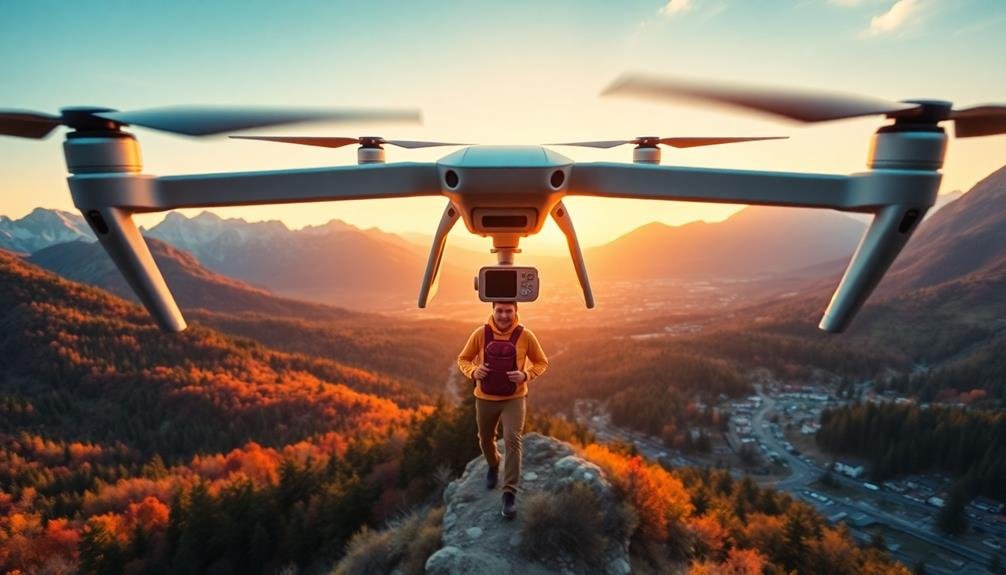
When selecting a drone for follow-me mode, you'll want to prioritize models with robust autonomous flight capabilities.
You should also consider the camera quality, as it directly impacts the footage you'll capture during follow-me sequences.
Don't overlook battery life, which determines how long you can use the follow-me feature before needing to recharge or swap batteries.
Autonomous Flight Capabilities
Autonomy stands at the forefront of modern drone technology, revolutionizing the way we capture aerial footage. When choosing a drone for follow-me mode, you'll want to prioritize models with advanced autonomous flight capabilities. These features enable your drone to navigate independently, avoiding obstacles and maintaining a safe distance while tracking you.
Look for drones equipped with intelligent flight modes, such as:
- ActiveTrack: Automatically follows and films a moving subject
- Obstacle Avoidance: Uses sensors to detect and avoid objects in its path
- Return-to-Home: Automatically returns to its starting point if it loses connection
Consider the drone's GPS and positioning systems, as they're essential for accurate tracking and stable flight. Some high-end models incorporate visual inertial odometry (VIO) for improved performance in GPS-denied environments.
Additionally, check the drone's battery life and range, ensuring it can keep up with your activities for extended periods.
Remember that autonomous capabilities vary between models and manufacturers. Research and compare different drones to find one that matches your specific needs and skill level.
With the right autonomous features, you'll be able to capture stunning follow-me footage without constantly worrying about manual controls.
Camera Quality Matters
Camera quality invariably plays an essential role in choosing the right drone for follow-me mode. You'll want a drone that can capture stunning footage while tracking your movements, so don't skimp on this vital feature. Look for drones with at least 4K resolution and high frame rates to guarantee smooth, detailed videos.
Consider the sensor size and type as well. Larger sensors generally perform better in low-light conditions and offer improved dynamic range. A 1-inch sensor or larger is ideal for professional-quality results. Pay attention to the camera's field of view and adjustable settings like ISO, shutter speed, and aperture.
Image stabilization is another critical factor. Opt for drones with both mechanical (gimbal) and electronic image stabilization to minimize shake and produce steady footage. Some advanced models even offer intelligent tracking features that keep the subject in focus while following.
Don't forget about photo capabilities. If you plan to capture still images during your adventures, look for drones with RAW shooting options and high megapixel counts. This will give you more flexibility in post-processing and allow for larger prints if desired.
Battery Life Considerations
Battery life is an essential factor when selecting a drone for follow-me mode. You'll want a drone that can keep up with your adventures without needing frequent recharges. Most consumer drones offer flight times between 20 to 30 minutes, but this can vary depending on factors like wind conditions and payload.
When using follow-me mode, your drone will be constantly adjusting its position and speed, which can drain the battery faster than normal flight.
To maximize your drone's battery life during follow-me sessions:
- Fly in favorable weather conditions to reduce battery strain
- Carry spare batteries and swap them out when needed
- Use power-saving features if available on your drone model
Consider investing in a drone with intelligent battery management systems. These can provide real-time information on battery status and estimated remaining flight time.
Some advanced drones even feature automatic return-to-home functions when battery levels get low, ensuring you don't lose your device mid-flight.
Optimal Settings for Smooth Tracking
Smooth tracking in follow-me mode relies heavily on fine-tuning your drone's settings. Start by adjusting your drone's speed to match your pace. For walking, set it between 2-4 mph; for running, increase to 6-8 mph. Slower speeds generally result in smoother footage.
Next, configure your drone's altitude. A height of 10-15 feet typically provides the best balance between capturing your surroundings and maintaining a clear view of you. Adjust this based on terrain and obstacles.
Set your follow distance to about 15-20 feet behind you. This allows the drone to anticipate your movements and react more smoothly. For side-tracking shots, increase this distance slightly.
Enable obstacle avoidance if your drone has this feature. It'll help prevent crashes and allow for more confident tracking through complex environments.
Adjust your gimbal settings for smoother footage. Set the gimbal speed to slow or medium, and enable horizon leveling if available. This keeps your footage stable even during sudden movements.
Mastering Subject Distance Control

To master subject distance control in follow-me mode, you'll need to understand ideal distance settings for your drone.
You can fine-tune these settings based on your specific drone model and the type of footage you're aiming to capture.
As you become more proficient, you'll learn to make dynamic proximity adjustments on the fly, adapting to changing environments and subject movements.
Optimal Distance Settings
Precision is key when mastering subject distance control in a drone's follow-me mode. You'll want to find the sweet spot that balances safety, visibility, and cinematic quality. Generally, a distance of 10-30 feet works well for most scenarios, but this can vary depending on your specific needs and environment.
Consider these factors when determining ideal distance settings:
- Subject speed: Faster-moving subjects may require greater distances for safety and smoother tracking.
- Obstacles: In areas with trees or buildings, keep your drone closer to navigate more easily.
- Desired shot composition: Wider angles need more distance, while close-ups require proximity.
Start by experimenting with different distances in an open area. Begin with a moderate 15-20 feet and adjust from there.
Pay attention to how the drone responds to your movements and the quality of the footage it captures. You'll quickly develop a sense for what works best in various situations.
Dynamic Proximity Adjustments
Mastering dynamic proximity adjustments takes your follow-me mode skills to the next level.
It's about adapting your drone's distance from the subject based on changing conditions and environments. You'll need to take into account factors like obstacles, lighting, and the subject's speed to maintain ideal framing and safety.
Start by familiarizing yourself with your drone's proximity sensors and obstacle avoidance systems. These features will help you make informed decisions about safe distances.
Practice adjusting your drone's follow distance on the fly using your controller or app. Many advanced drones allow you to set custom proximity thresholds for different scenarios.
Pay attention to your subject's movement patterns. If they're moving erratically or in a confined space, increase the follow distance to give your drone more time to react.
For smoother, more predictable movements, you can decrease the distance for more intimate shots.
Learn to anticipate changes in the environment. If you're approaching a forest or urban area, be prepared to increase the follow distance to navigate potential obstacles.
In open spaces, you can bring the drone closer for more detailed footage.
Always prioritize safety and local regulations when making these adjustments.
Navigating Obstacles During Flight

Obstacle avoidance is a critical skill for drone pilots using follow-me mode. As you move through various environments, your drone must navigate around trees, buildings, power lines, and other potential hazards. To guarantee safe flight, always maintain visual line of sight with your drone and be prepared to take manual control if necessary.
When flying in follow-me mode, keep these tips in mind:
- Plan your route in advance, considering potential obstacles and areas with clear airspace
- Adjust your drone's altitude to avoid low-hanging branches or overhead wires
- Use the drone's obstacle avoidance sensors, but don't rely on them entirely
Most modern drones come equipped with obstacle detection systems, but they're not foolproof. You'll need to stay vigilant and anticipate potential hazards. If you're approaching a complex obstacle course, consider switching to manual control temporarily. This allows you to guide the drone through tight spaces with greater precision.
Remember that different environments present unique challenges. In urban areas, watch for sudden changes in building heights and unexpected structures.
In natural settings, be mindful of uneven terrain and vegetation that may obstruct your drone's path. By staying alert and proactive, you'll master the art of obstacle navigation in follow-me mode.
Maximizing Battery Life
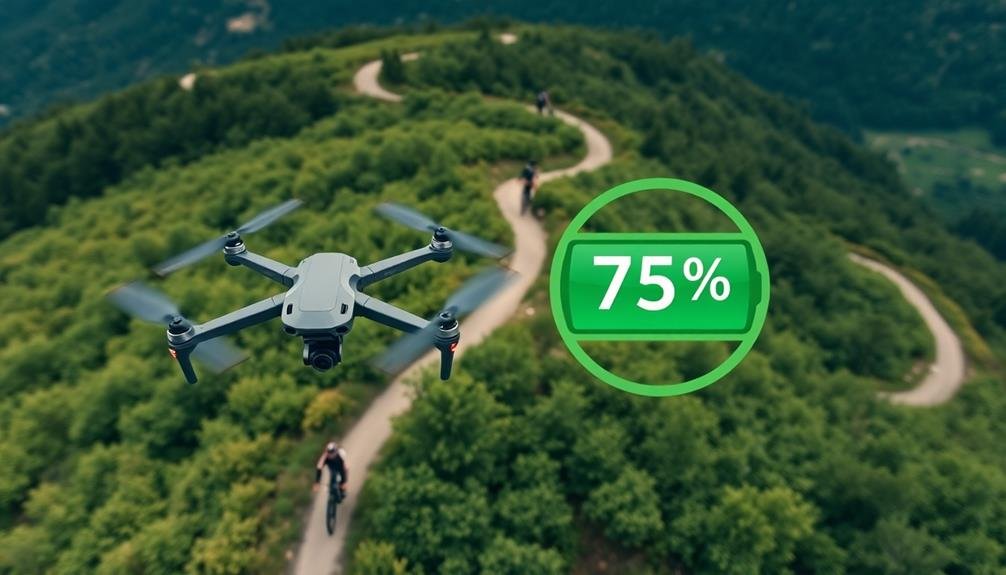
While maneuvering obstacles is key to safe flying, keeping your drone airborne for as long as possible is equally important. To enhance battery life during follow-me mode, start by fully charging your battery before each flight.
Calibrate your drone's compass and IMU to guarantee efficient power usage. Fly in ideal weather conditions, as wind resistance can drain your battery faster.
Adjust your drone's speed to match your pace, avoiding unnecessary accelerations and decelerations. Use the best following distance to reduce power consumption. If your drone has different follow modes, choose the one that's most energy-efficient for your activity.
Monitor your battery levels closely and set a return-to-home threshold. Disable unnecessary features like obstacle avoidance when flying in open areas. Consider carrying spare batteries for longer sessions.
If your drone supports it, use intelligent battery management systems to enhance power usage. Maintain your drone regularly, checking for loose connections or damaged components that may affect power efficiency.
Perfecting Cinematic Shots

To create stunning cinematic shots with your drone's follow-me mode, focus on smoothing camera movements.
You'll want to adjust your drone's settings to guarantee fluid pans and tilts as it tracks your subject.
For dynamic action shots, experiment with framing techniques like the rule of thirds or leading lines to add visual interest and guide the viewer's eye.
Smoothing Camera Movements
A drone's cinematic potential truly shines when its camera movements are smooth and fluid. To achieve this, you'll need to master both your drone's controls and its built-in stabilization features. Start by adjusting your drone's settings to enable smooth acceleration and deceleration. This will help prevent jerky movements that can ruin your shots.
Practice flying at different speeds and altitudes to understand how your drone behaves in various conditions. When executing moves like pans or tilts, use gentle, gradual inputs on the controller to maintain a steady motion. Remember, subtle movements often yield the most professional-looking results.
To further enhance your footage, consider these techniques:
- Use natural objects as visual guides for smooth tracking shots
- Incorporate slow, sweeping movements to create a sense of scale
- Experiment with different flight paths to add depth to your compositions
Don't forget to leverage your drone's intelligent flight modes, such as orbit or waypoint, which can automate complex camera movements.
Framing Dynamic Action Shots
For capturing dynamic action shots, framing is essential to create enchanting cinematic footage. When using follow-me mode, position your drone to capture the subject from various angles. Try to maintain the rule of thirds, placing your subject along imaginary grid lines or at their intersections. This technique adds visual interest and balance to your shots.
Experiment with different heights and distances to add depth and perspective to your footage. Low-angle shots can make your subject appear more powerful, while high-angle shots provide a sense of scale and context. Don't forget to take into account the background; verify it complements your subject without becoming distracting.
| Shot Type | Angle | Effect |
|---|---|---|
| Low Angle | Upward | Empowering |
| High Angle | Downward | Diminishing |
| Eye Level | Straight | Natural |
When framing dynamic action, anticipate your subject's movement and leave room in the frame for them to move into. This technique, known as "lead room" or "nose room," creates a more natural and engaging composition. For fast-moving subjects, try using a wider frame to guarantee you don't lose them as they move. Remember to adjust your drone's speed and direction smoothly to maintain proper framing throughout the shot.
Weather Considerations for Follow-Me
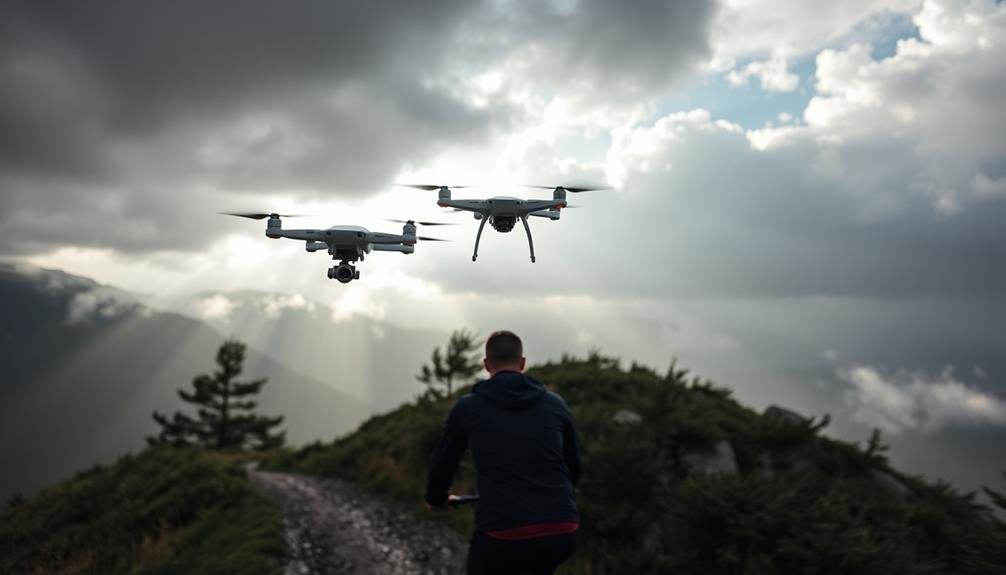
Weather plays an essential role in successful follow-me drone operations. You'll need to take into account various factors to guarantee your drone can safely and effectively track you in different conditions. Wind speed is vital; strong gusts can throw off your drone's trajectory and drain its battery faster. Always check the forecast before flying and avoid winds exceeding 20-25 mph.
Temperature affects battery life and performance. In cold weather, your drone's flight time may decrease considerably, so pack extra batteries and keep them warm. Hot temperatures can cause overheating, so avoid flying in extreme heat or direct sunlight for extended periods.
Visibility is another important factor. Make sure there's enough light for your drone's sensors to function properly. Avoid flying in fog, heavy rain, or low-light conditions that can interfere with tracking accuracy.
Here are some additional weather considerations:
- Humidity: High humidity can affect electronic components and cause condensation.
- Precipitation: Even light rain can damage your drone's internal systems.
- Atmospheric pressure: Sudden changes can affect altitude readings and stability.
Advanced Tracking Patterns
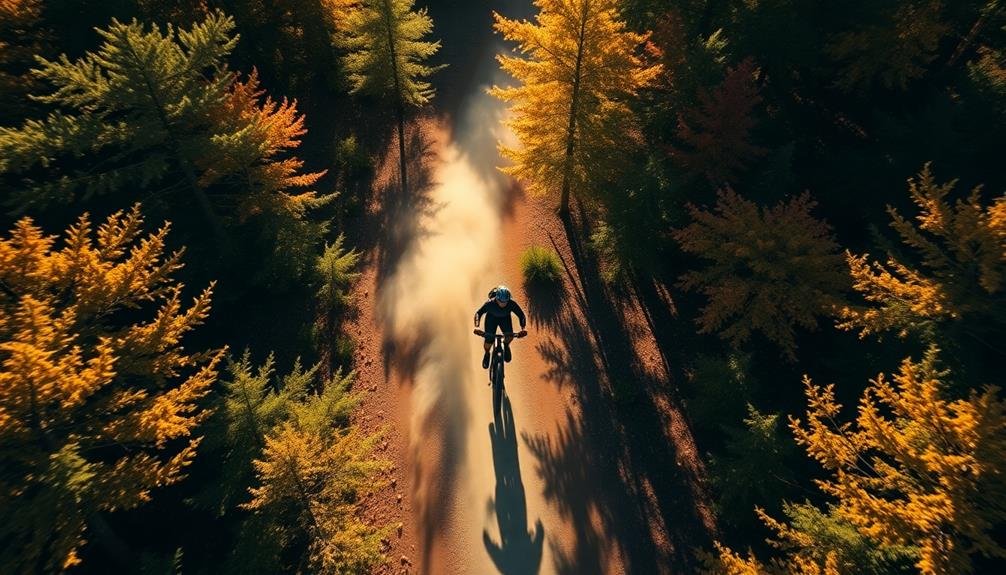
Once you've mastered basic follow-me modes and weather considerations, it's time to explore advanced tracking patterns. These techniques will elevate your drone footage and create more dynamic, cinematic shots.
Advanced tracking patterns involve combining multiple movements and adjusting your drone's position relative to the subject. Some popular patterns include orbiting, reveal shots, and parallax movements. To execute these effectively, you'll need to take into account your subject's speed, direction, and surrounding terrain.
Here's a quick reference guide for advanced tracking patterns:
| Pattern | Description | Best Used For | Difficulty | Cinematic Impact |
|---|---|---|---|---|
| Orbit | Circular motion around subject | Showcasing landscapes | Medium | High |
| Reveal | Slowly exposing the subject | Dramatic introductions | Easy | Very High |
| Parallax | Foreground/background separation | Adding depth to scenes | Hard | High |
| Flyby | Passing the subject at speed | Action sequences | Medium | Medium |
| Elevator | Vertical ascent or descent | Establishing shots | Easy | Medium |
Practice these patterns in open areas before attempting them in more challenging environments. Remember to always prioritize safety and adhere to local drone regulations while pushing your creative boundaries.
Combining With Other Flight Modes
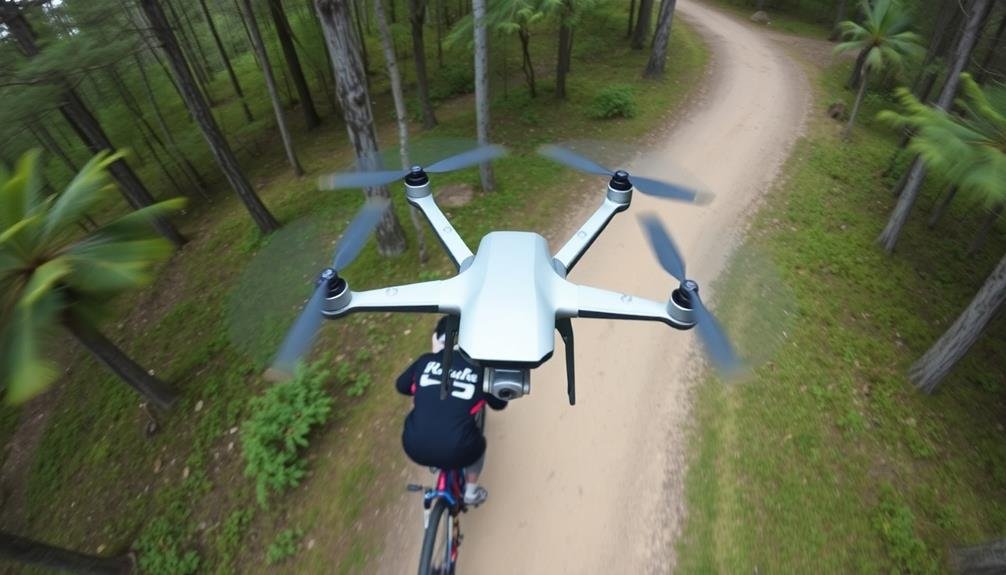
The true power of follow-me mode lies in its ability to seamlessly integrate with other flight modes. You can create dynamic and compelling footage by combining follow-me with modes like orbit, waypoint, or terrain tracking.
For instance, start with follow-me as you hike up a trail, then switch to orbit mode when you reach a scenic overlook. This combination allows you to capture both your journey and the breathtaking panorama.
To effectively combine flight modes:
- Plan your shots in advance, considering changes between modes
- Practice smooth mode switching to avoid jarring footage
- Use intelligent flight modes that complement follow-me, like ActiveTrack or Point of Interest
Don't hesitate to experiment with different combinations. Try alternating between follow-me and waypoint mode to create a cinematic sequence that showcases both your movement and predetermined flight paths.
You can also incorporate manual flight controls during follow-me mode for more precise framing or to navigate obstacles. By mastering these combinations, you'll elevate your drone videography, producing professional-quality content that stands out from typical follow-me footage.
Post-Processing Follow-Me Footage
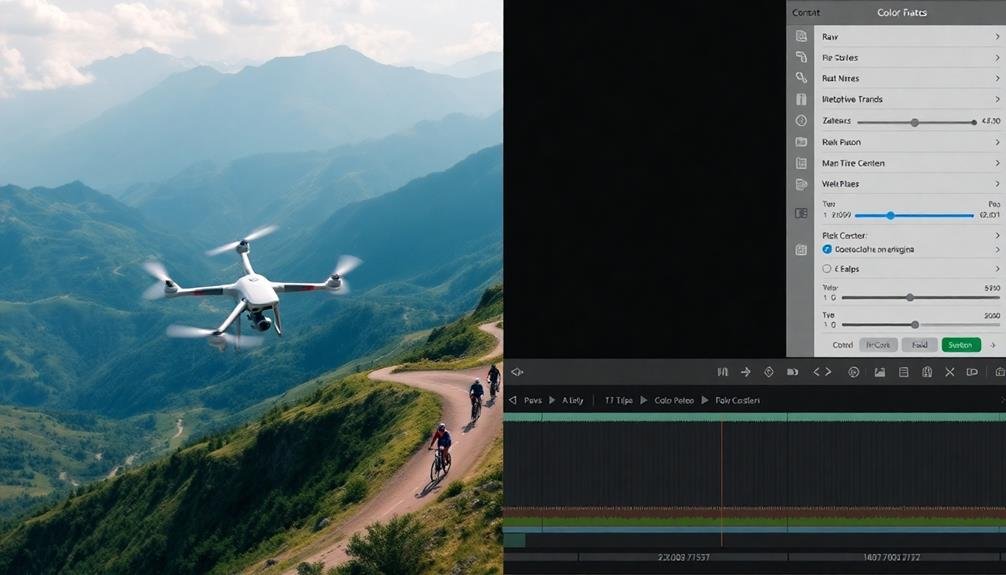
Post-processing is where your follow-me footage truly comes to life. After capturing dynamic shots of yourself or your subject in motion, it's time to refine and enhance your raw footage.
Start by organizing your clips and selecting the best takes. Trim unnecessary sections to maintain a tight, engaging narrative.
Color correction is essential for follow-me footage, as lighting conditions often vary during movement. Adjust exposure, contrast, and white balance to create a consistent look across your sequence.
Consider applying a color grade to give your footage a cinematic feel.
Stabilization is key for smooth follow-me shots. Use your editing software's built-in stabilization tools to minimize shake and jerky movements.
For more advanced results, try third-party plugins designed specifically for drone footage stabilization.
Add slow-motion effects to highlight particularly dramatic moments, but use this technique sparingly.
Incorporate dynamic shifts between clips to maintain flow and energy. If you've recorded separate audio, sync it carefully with your visuals.
Legal Considerations for Autonomous Flight
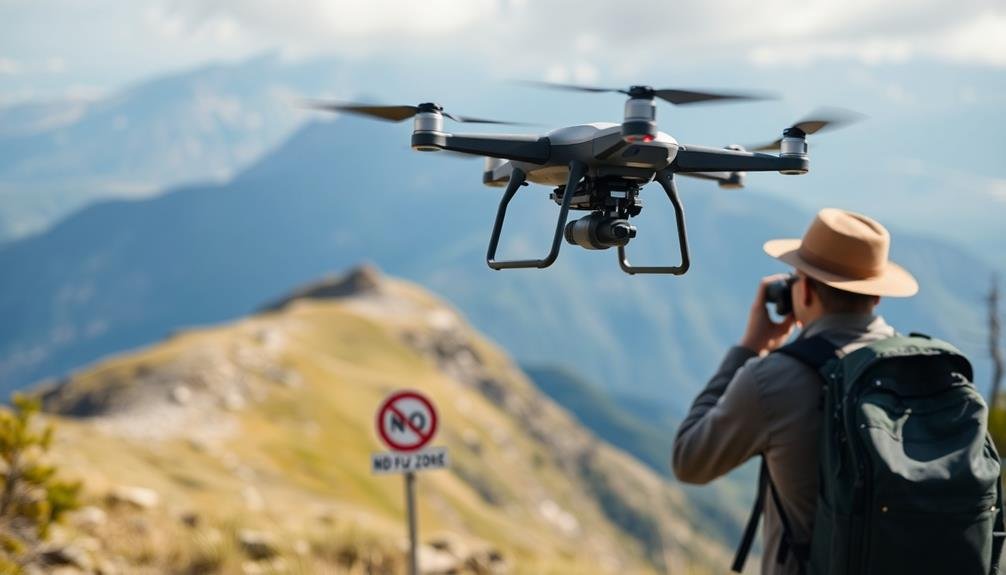
Before you engage your drone's follow-me mode, it's crucial to understand the legal landscape surrounding autonomous flight. Many countries have specific regulations for autonomous drone operations, and follow-me mode often falls into this category. Check your local laws to verify you're compliant before taking off.
In most jurisdictions, you'll need to maintain visual line of sight with your drone at all times, even when it's following you autonomously. This means you can't let it fly behind obstacles or out of your view. Additionally, you're still responsible for avoiding collisions and maintaining safe distances from people, vehicles, and structures.
Consider these key legal aspects:
- Obtain necessary permits or licenses for autonomous flight
- Respect no-fly zones and restricted airspace
- Adhere to maximum altitude restrictions
Remember that privacy laws apply to drone footage, especially when using follow-me mode in public spaces. Be mindful of capturing images or videos of others without their consent.
If you're unsure about the legality of your planned flight, consult with local authorities or a drone law expert. Stay informed about changing regulations, as drone laws are constantly evolving to keep pace with technological advancements.
Frequently Asked Questions
Can Follow-Me Mode Be Used for Indoor Filming?
You can use follow-me mode indoors, but it's challenging. You'll need a drone with obstacle avoidance and precise positioning. Be cautious of tight spaces, low ceilings, and poor GPS signal. Consider manual control for better results.
How Does Follow-Me Mode Perform in Crowded Urban Environments?
In crowded urban environments, you'll find follow-me mode can struggle. It's prone to losing sight of you, confusing other people for its target, and encountering obstacles. You'll need to be extra cautious and maintain visual contact.
Is It Possible to Switch Subjects During a Follow-Me Flight?
Yes, you can switch subjects during a follow-me flight. You'll need to pause the current tracking, select your new subject, and reactivate follow-me mode. Some drones allow this through their app or remote controller interface.
Can Follow-Me Mode Track Multiple Subjects Simultaneously?
You'll find that most drones can't track multiple subjects simultaneously in follow-me mode. They're designed to focus on a single target. If you need to track multiple subjects, you'll likely need to switch between them manually.
Are There Any Special Considerations for Using Follow-Me Mode at Night?
When using follow-me mode at night, you'll need to guarantee your drone has proper lighting. Use high-visibility clothing and consider attaching LED lights to yourself. Be aware of local regulations and visibility limitations in low-light conditions.
In Summary
You've now revealed the secrets of follow-me mode for your drone. With the right equipment, settings, and techniques, you'll capture stunning footage while flying hands-free. Remember to practice in safe environments and stay aware of obstacles. Don't forget to experiment with advanced patterns and combine modes for unique shots. Always check local laws before engaging autonomous flight. Now go out there and let your drone follow your lead!

As educators and advocates for responsible drone use, we’re committed to sharing our knowledge and expertise with aspiring aerial photographers.
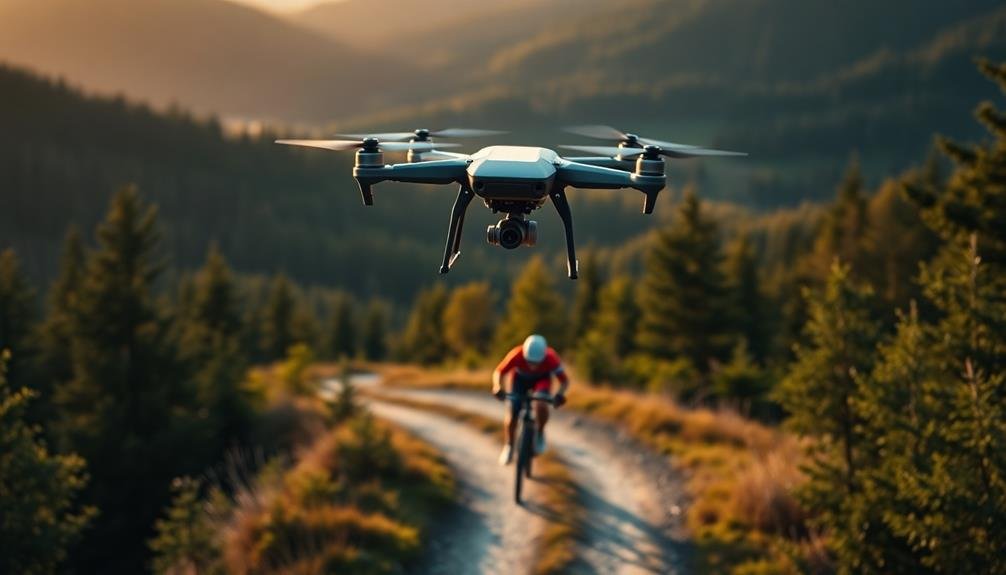



Leave a Reply